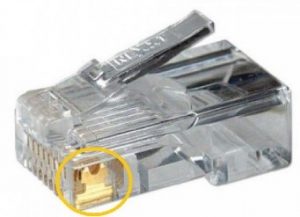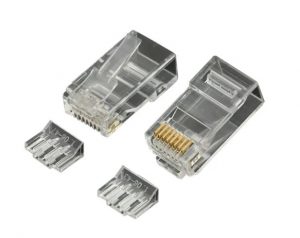What is the Difference Between Cat5, Cat6, Cat7, and Cat 8 Connectors?

Table of Contents
I will cover the difference between connectors (ethernet cable ends) of cat5e, cat6, cat6a, cat7, and cat8 categories and whether cat5e and cat 6 connectors are the same in this article.
What is an RJ45 Connector?
It can be interpreted as a standardized interface. The abbreviation RJ stands for “Registered Jack.” It is also called RJ45, modular plug, 8P8C, end, connector.
With the development of technology and the emergence of many different types of equipment, creating a universal interface for organizing connections among devices.

Connectors based on several conductive contacts, capable of simultaneously transmitting electrical impulses through several channels, were able to cope with this task best of all. At the same time, the practical and straightforward structure of RJ connectors allowed manufacturers to produce them relatively inexpensively and use them everywhere. That was the key to the popularity of the RJ interface.
RG Connector Design
All types of RJ connectors are very close in structure and represent a piece of plastic with 50 microns golden contacts inside. There are options with a thin layer of gilding. The fact is that the thickness of the gold coating layer affects both the quality of the transmission of an electric signal and the number of possible connections. It would be best if you did not choose connectors with a gilt thickness of fewer than 50 microns. Such savings will result in reduced operating resources and degraded data transfer rates.

Also, you should pay attention to the quality of plastic. Sometimes, polymer secondary raw materials are used to reduce the cost of connector production.
As a result, you can see cracks and blurriness on the plastic or even a slightly cloudy transparent material instead of a perfectly transparent colorless plastic. The use of such connectors may end at the beginning of their use – during the crimping process because they often crumble into pieces or crack under the pressure of the crimping tool.
A retaining latch is located on top. It is responsible for fixing the connector in the port.

There is a hole for feeding the twisted pair cable during crimping on the backside. Inside the case, the blades are located closer to the front.
Three types of pins for RJ connectors:
- for solid

- for stranded

- universal

You need to pay attention to the type of conductor, which can be solid or stranded. You need to know that RJ45 connectors differ in the shape of the contact pin. These pins are two-point and three-point, with two or three different blades on each contact. The two-prong pin can be designed for solid or stranded wires. The wrong choice of a mortise pin leads to a short-lived connection or its absence. Three-point mortise pins are universal and suitable for any conductor. Incorrect pin selection leads to a short-lived connection or its lack. Three-point pins are versatile and ideal for any conductor.

The piercing-type contact (IPC) was also designed to work with an insulated wire. The plane of the working part of such a contact is always located parallel to the axis of the wire — this is one of the main external distinguishing features of piercing-type contacts.
Types of Connectors
By the number of positions and contacts
If we consider this type of connecting equipment according to modifications, we first need to deal with the number of positions and contacts.

The labeling of products always indicates the parameters indicated by the letters P and C.
P – the number of positions (slots for placing gold-plated contacts)
C – the actual number of contacts

Thus, the RJ-45 8P8C connector looks like this:

Based on these parameters, the types of RJ connectors can be divided into:
- RJ 11 (4P4C) – installed in handsets and some other outdated devices
- RJ 12 (6P4C and 6P6C) – used in telephones and some models of network devices
- RJ 45 (8P6C and 8P8C) – standard connector for patch cords, network, multimedia, gaming, computer, and other devices
Types of connectors classified by crimping
On this basis, the models are divided into:
• Standard — equipped with the front of the plug body, where the conductors of the twisted cable are stuck.
• Pass through — there is no the front. The conductors pass through the connector during crimping.

The conductors may get mixed up and get into the wrong slots when crimping the standard ends. Pass through models facilitate pinout. In addition, in the case of simple connectors, the conductors may not reach the contacts, so the connection will not happen. The use of pass-through connectors eliminates this possibility.
Now let’s talk about the differences between the models regarding technical characteristics.
Shielded and unshielded connectors
There are also RJ-45 shielded connectors. Unlike unshielded connectors, they have a protective shield made of thin metal against electromagnetic interference. Such products are labeled as STP or FTP.

Shielded connectors are equipped with a protective shield in the form of a metal coating that removes electromagnetic waves. Often these are FTP connectors, but they may have other markings, for example, STP. They are used in places where electromagnetic radiation can affect the signal. UTP connectors are used unshielded. The telephone ends are not equipped with protective shields.
FTP connectors should be used only in shielded networks where all components have protection and grounding. Otherwise, the shielded connector will also properly perform its data transmission function, but it will not be able to protect your network from interference from powerful equipment or power cables.
Categories of RJ connectors
Each type of connector has a network category. This parameter lets you know with what equipment and cable the connector can be used and indicates the speed parameters of data transmission that it can support.
In addition to design features, connectors differ from each other by category. It indicates the maximum data transfer rate. The category is always the third at the telephone ends (RJ-11 and RJ-12). But the connector for the Internet cable can belong to categories 5, 5e, 6, and 6a, as well as 7 and 7a. However, cat5e with gigabit speed and cat6 connectors are the most popular. They support data transfer up to 10 Gbps.
Categories and connectors:
- RJ-45 – Category 5e, 6
- RJ-11, RJ-12 – Category 3
Everything you need to know about network categories is here.
Remember! Cables, connectors, and patch panels must be identical in category and type of shielding. It is also important to remember that using a protective shield makes grounding mandatory.
What is the Difference between RJ45 Connectors for Cat5, Cat5e, Cat6, Cat6a, Cat7, and Cat 8
CAT5 and CAT 5e
There are no physical differences between these categories. Metal linings are used for shielded connectors. The difference lies in the speed (up to 100 and 1000 Mbit/s) of data transmission, which differs by an increased clock cycle of the intermediate signal transmission frequency up to 100 Mhz.
In 2022, the Category 5 standard is considered obsolete.
In the 8p8c cat5 and cat5e jacks, 8 conductors are arranged precisely horizontally.

The difference between ethernet cable ends for Cat 6, Cat 6a, Cat 7, and Cat 8.1. Are they the same?
In the jacks cat 6, cat 6a, and cat7 of the twisted pair, eight conductors are arranged precisely in a zigzag pattern (staggered).

In addition, for the convenience of crimping a cable of twisted wire pairs, a plastic load bar is included.

RJ-45 cat 6 connectors are suitable for transmitting information at speeds up to 1 Gbit per second (Fast Ethernet or Gigabit Ethernet) at a signal frequency of 250 Mhz. This type is suitable for future-proofing LAN.
RJ-45 cat6a connectors are suitable for transmitting information at a speed of up to 10 Gbps (up to 55 meters) per second Fast Ethernet or Gigabit Ethernet at a signal frequency of 500 Mhz. This standard was approved in February 2008, and only 10 years later, it began to be distributed in LAN (local area networks). These connectors are used in data centers where hardware requires increased data transmission requirements. For home use, cat 6A connectors are redundant.
RJ45 cat 7 connector – transmission up to 10 Gbps, Non-RJ 45 connector type, frequency 600 MHz. It is used strictly with a shielded connector and a twisted shielded (FTP, STP, SFTP) cable. The signal frequency is about 600-700 Mhz. This standard has been approved by ISO/IEC 11801 (International organization for Standardization). Twisted pairs of this standard have a shield in each pair and a common shield.

This type is used in data centers and facilities where the maximum data transfer rate is required.
RJ45 CAT 8.1 Connector – In development, technical recommendation ISO/IEC TR 11801-99-1 and international standard ISO 11801 Revision 3 (for Cat. 8.1), American standard ANSI/TIA-568-C.2-1 (for Cat. 8). Fully compatible with Category 6A cable. The data transfer rate is up to 40 Gbit/s when using standard 8P8C connectors. The cable of this category has either a common shield or shields around each pair (F/UTP or U/FTP)

Cat5e (Cat5) vs. Cat6 Сonnectors. What is the Fundamental Difference?
The only question is the requirement for the category, that is, the upper frequency to which the network is being tested (100 or 250 Mhz). The presence of the shield does not affect the category. There are options for shielded (FTP) and unshielded (UTP). Both are shielded and unshielded.
The difference:
- Well, they differ a bit in the design. The connectors themselves vary in the thickness of the holes for the wires. The conductors of the 6 categories are slightly thicker. It is not very convenient to insert them into the 5e connector, although it is quite realistic.
- Cat5e is not certified for 1Gb Ethernet.
- The price difference between CAT5e versus CAT6 is minimal now.
- Another thing to note is that since the change to 23 AWG, most models used have changed to a staggered layout instead of one row to create a further separation of wires.
Why does Cat6 RJ-45 Work Many Times Faster than Cat5?
They do not differ in appearance, and the topology of the location of conductors and contacts is designed, taking into account work at higher frequencies. What is confirmed by the test results: the 5th category does not pass the 6th on the tests. A set of tests and measured values are available on the network.
